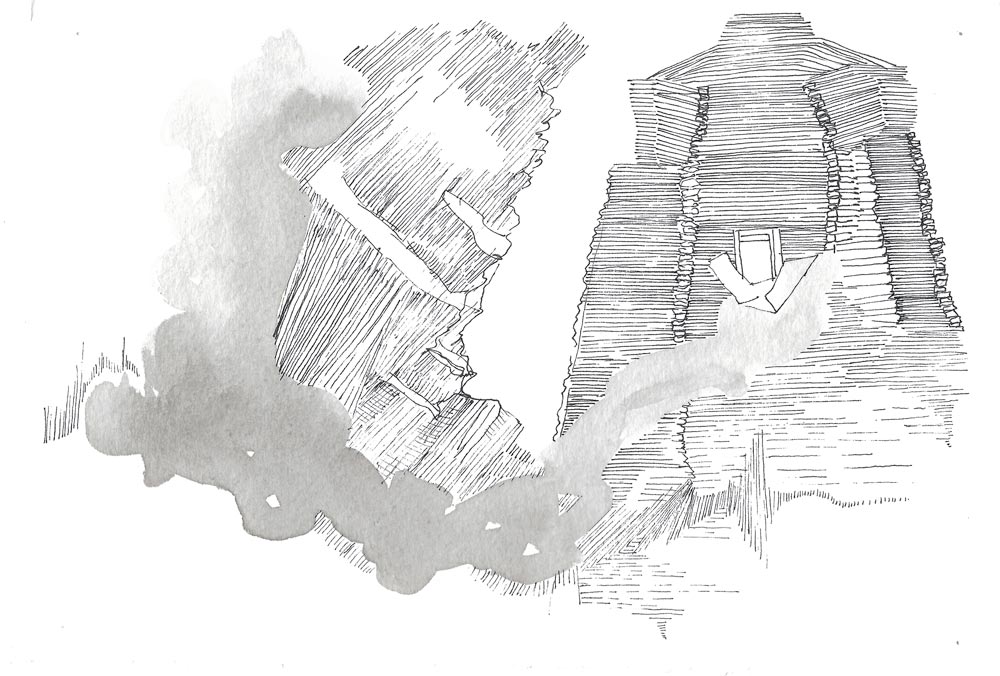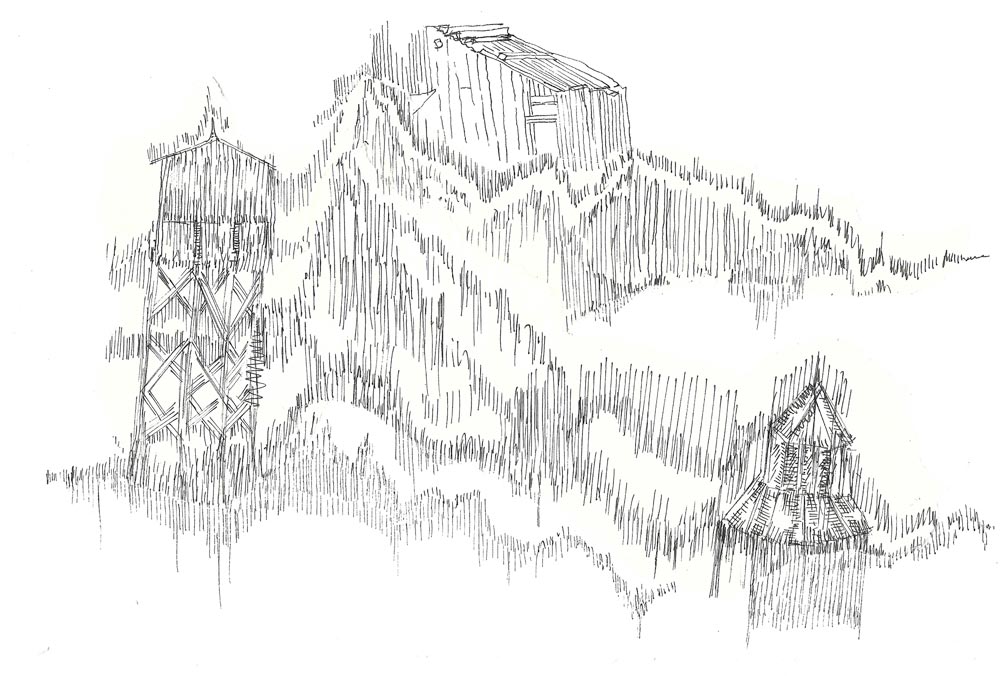
The Library of Babel, detail of installation form the exhibit Betrayal at Babylon at Burnaby Art Gallery, September 2016. Kit bashed models, 3D printing, crystals, wood, spray foam, paint. Photo: Blaine Campbell.
Keith
Langergraber
Keith Langergraber applies research-based methodologies to the architecture of mining, to reflect issues around resource extraction, regional ecologies and histories, speculative futures, and climate change. Langergraber’s series of drawings depict abandoned mining buildings from the Kootenay region, focusing mainly on a concentrator at Retallack, as well as ghost town ruins from the regions of Nelson, New Denver and Kaslo. The artist conceives of these representations of abandoned mining structures as personifications of climate change. They are echoes of form emerging from stasis, depicting the ruined remnants of a once burgeoning but destructive resource industry.
These drawings combine a familiar sense of the local with a sense of strangeness. Through material handling they mimic the chaotic characteristic of climate change which pulls further into itself, reminding us through abnormal weather events that we are moving forward on an inexorable cascading wave. The artists intention is to create a subtle range of harmonics through both architectural and vibrating lines, evoking the near past butted up against an alarmingly unpredictable future.
Also included in the installation are sculptures consisting of kit-bashed and 3D printed elements, and other assembled structures. They are joined together into scaled down versions of hulking abandoned architecture. They form three complex pieces that establish an uneasy relationship with the framed drawings. These work’s fabrication reveals ruptures in scale, reminiscent of natural history models but are asymmetrical and baroque in the level of obsessive detail. With this coexistence of spectre and form within an installation, Langergraber’s aim is to ‘tune’ cognition towards mining structures, nested in the ‘noise’ of frenetic lines. The installation comprises ephemeral signposts from the past, pointing to greater calamities on the horizon.

Mining Concentrator - Dissonance Studies (1 of 12), micron marker and Chinese/India ink on paper, series created between 2019-2021, 6" x 9"

Mining Concentrator - Dissonance Studies (2 of 12), micron marker and Chinese/India ink on paper, series created between 2019-2021, 6" x 9"

Mining Concentrator - Dissonance Studies (3 of 12), micron marker and Chinese/India ink on paper, series created between 2019-2021, 6" x 9"
Keith Langergraber received his BFA from the University of Victoria and his MFA from the University of British Columbia. He has shown his work extensively in solo and group exhibitions in galleries in Canada, the United States, and Asia since 1995, most recently at the Southern Alberta Art Gallery, Burrard Art Foundation and the Burnaby Art gallery. He has received many grants and awards for his work including a Sobey Award nomination, and has given numerous lectures and presentations on his artistic research. In 2005 he was selected to represent Emily Carr at the Canadian Art Colleges Collaborative Banff Residency, Media and Visual Arts, Banff, Alberta. Langergraber researches specific sites to explore social, cultural, and political change. His research and art allows an understanding of the shifts that have taken place at that location over time. Keith Langergraber is a lecturer at Emily Carr University of Art and Design.
Kootenay Gallery of Art
120 Heritage Way
Castlegar, BC V1N 4M5
kootenaygallery[dot]telus.net
250-365-3337
Oxygen Art Centre
#3-320 Vernon St. (alley entrance)
Nelson, B.C. V1L4E4
info[dot]oxygenartcentre.org
250-352-6322
We acknowledge with gratitude that our art spaces are located on the unceded traditional territory of the sn̓ʕay̓ckstx (Sinixt Arrow Lakes), Sylix (Okanagan Nation Alliance) and Ktunaxa (specifically Yaqan Nukij Lower Kootenay Band peoples). We recognize the enduring presence of First Nations people on these lands and that these territories are home to Métis and many diverse Indigenous persons.